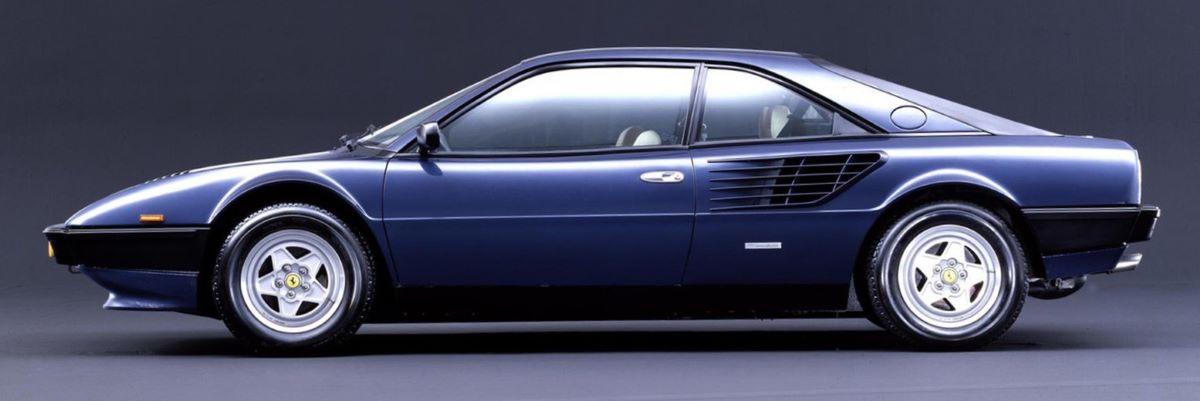
Mondial Quattrovalvole
While all manufacturers (including Ferrari on its smaller capacity V8s) were pursuing the turbo route to increase power and performance (at the cost of higher fuel consumption and more costly mechanics), for this more mainstream sports car Ferrari’s engineers decided to opt for the 4-valve per cylinder engine. With a 32-valve head, the 240 bhp Mondial was basically equipped with the same technical modifications as adopted for the 308. The result was a more revvy and powerful engine that helped underline the car’s overtly sporty nature
The Mondial Quattrovalvole succeeded the Mondial 8 model in 1982, with the Quattrovalvole part of the model title referring to the adoption of four valves per cylinder, instead of the two used on the preceding model. The new four valves per cylinder heads produced a significant increase in power output, and thus road performance, which had been a criticism of the Mondial 8, even though it was still ahead of most cars on the road at the time.
As with the Mondial 8, the Mondial Quattrovalvole continued the same wedge body shape theme with the radiator grille beneath the front bumper. The overall shape was identical to the preceding model, including the black plastic wrap around bumpers front and rear, together with the large trapezoidal air intake grilles for the engine bay on the body sides behind the doors, and paired circular rear light assemblies. Although the exterior remained unchanged, apart from the replacement of the Mondial 8 badge with Mondial Quattovalvole badging to the tail panel, the interior was lightly modified, mainly in respect of the centre console layout. The console was extended forward to meet the front bulkhead, and the ventilation controls incorporated into it, whilst the radio position moved from behind the gear change to a more clearly visible location ahead of it. The door panels had revised pattern pockets and pulls, whilst the leather rim steering wheel became plain spoke (instead of slotted) with a satin black finish.
The main European market Mondial Quattrovalvole models had a tubular chassis with factory type reference F 108 BL 100, which featured a bolted rear sub-frame section, so that the complete engine, transmission and rear suspension assembly could be removed as a single unit, for ease of maintenance.
Apart from the four valves per cylinder heads, the V8 engine of the Mondial Quattrovalvole was basically the same design as that used in the Mondial 8 model, fitted with Bosch K Jetronic fuel injection and Marelli MED 803A Digiplex electronic ignition to produce a claimed 235bhp for main European market versions, and 230bhp for US market versions. It was of a 90 degree configuration, with belt driven twin overhead camshafts per bank, having a total capacity of 2926cc, with a bore and stroke of 81mm x 71mm, bearing factory type reference F 105 A 000 for European market cars. In the engine bay the Quattrovalvole engine can be identified by the elegant red crackle finished intake casting, with machined aluminium ribs and bearing the script Ferrari Quattrovalvole. The engine was transversely mounted in unit with the all synchromesh five speed transmission assembly, which was below, and to the rear of the engine’s wet sump. The model featured independent suspension via wishbones, coil springs and hydraulic shock absorbers all round, with front and rear anti roll bars.
As with the concurrent 2 seater models both right and left hand drive was available, together with various world market specification models. Mondial Quattrovalvole models were produced prior to the chassis number 75000, from which point both odd and even numbers were used for chassis numbers, thus all cars in this series carry odd number only chassis numbers. They were produced between 1982 and 1985, during which time 1145 examples were produced, in the chassis number range 41737 to 59131.
Mondial Quattrovalvole Specifications and Features
- (1989-1993) 858 produced
Engine
- Type……………………………rear, transverse, 90° V8
- Bore/stroke………………….81 x 71 mm
- Unitary displacement…….365.86 cc
- Total displacement………..2926.90 cc
- Compression ratio…………9.2 : 1
- Maximum power………….176 kW (240 hp) at 7000 rpm
- Power per litre……………..82 hp/l
- Maximum torque………….260 Nm (26.5 kgm) at 5000 rpm
- Valve actuation……………..twin overhead camshafts per bank, four valves per cylinder
- Fuel feed………………………Bosch K-Jetronic injection
- Ignition………………………..electronic, single spark plug per cylinder
- Lubrication…………………..wet sump
- Clutch…………………………single-plate
Chassis
- Frame……………………………tubular steel
- Front/Rear suspension……independent, unequal-length wishbones, coil springs over telescopic shock absorbers, anti-roll bar
- Brakes…………………………..discs
- Transmission………………..5-speed + reverse
- Steering………………………..rack-and-pinion
- Fuel tank………………………capacity 87 litres
- Front tyres…………………….240/55 VR 390
- Rear tyres……………………..240/55 VR 390
Bodywork
- Type………………………….2+2 coupé
- Length………………………4580 mm
- Width……………………….1790 mm
- Height………………………1260 mm
- Wheelbase………………..2650 mm
- Front track………………..1495 mm
- Rear track…………………1517 mm
- Weight……………………..1430 kg (dry)
Performance
- Top speed……………………240 km/h
- Acceleration
0-400 m……………………..14.8 sec
0-1000 m…………………….27.5 sec


You must be logged in to post a comment.